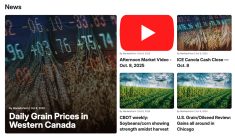The imminent arrival of electronic trading hasn’t scared traders from using the Winnipeg Commodity Exchange.
Whether liquidity will slump after the switchover from open outcry to electronic trading can’t be known until after the change Dec. 20, but there are no signs of trouble in 2005 futures contracts.
“I don’t see anything weird happening,” said canola market analyst Nolita Clyde of Ag Commodity Research.
“Open interest has been going higher recently, so there’s no indication yet of problems.”
Open interest is the measure of the number of outstanding contracts in a month. When open interest increases, it means more people are becoming involved in a market. The more open interest in a contract, the easier it is to trade and to offset earlier positions, which is known as liquidity.
Read Also

Huge Black Sea flax crop to provide stiff competition
Russia and Kazakhstan harvested huge flax crops and will be providing stiff competition in China and the EU.
Increasing levels of open interest are taken to be signs of good health for a contract and an exchange. It is a key factor trading companies use when deciding whether to use a contract and an exchange.
The recent increase in open interest for canola contracts, especially November 2005 canola contracts, shouldn’t be taken as a vote in favour of electronic trading, cautioned Tony Tryhuk, the manager of commodity trading for RBC Investments.
That increasing open interest is being produced by large volumes of canola coming to the market, and by a large Cargill 2005 canola program, which was hedged and created opportunities for traders. It has nothing to do with electronic trading, he said.
But electronic trading has not scared off traders, and that is significant.
“The companies that currently trade Winnipeg are not too concerned about potential liquidity risk in electronic trading and are prepared to trade our market if they see an opportunity,” said Tryhuk.
“There’s confidence that the market will not be unsuccessful. It’ll be there, so we’ll be able to trade it.”
Ken Ball of Benson Quinn-GMS said companies using the exchange had been worried that the switch would scare off too many floor traders before the changeover occurred.
“We were worried that the floor trading population might diminish to the point that actual trading would become difficult, but everything seems to be fine,” said Ball. “Everything seems to be normal.”
Once the last buzzer sounds on Dec. 20 trading will change, not just in format but also in terms of who is using the market.
Independent floor traders who buy and sell on the minute-by-minute basis of momentum will probably disappear and that may suck some liquidity out of the market, said Clyde.
“It’s hard to say who will stay around,” she said.
But WCE chief executive officer Mike Gagne said new liquidity should come to the market from the 15-20 new Futures Commission Merchants that hope to use the exchange once it is electronically traded. FCMs trade contracts for clients that pay them a commission.
Not only have FCMs said they are interested in using the exchange, but most have already registered to trade the exchange’s contracts and are now running computer simulations of its contracts.
Gagne said two of the FCMs are Canadian, but most are American. There are also a couple of proprietary traders, which are companies that speculate with their own money on futures contracts.
“We’re very pleased with that,” said Gagne.
“We’re very pleased with the interest.”

















